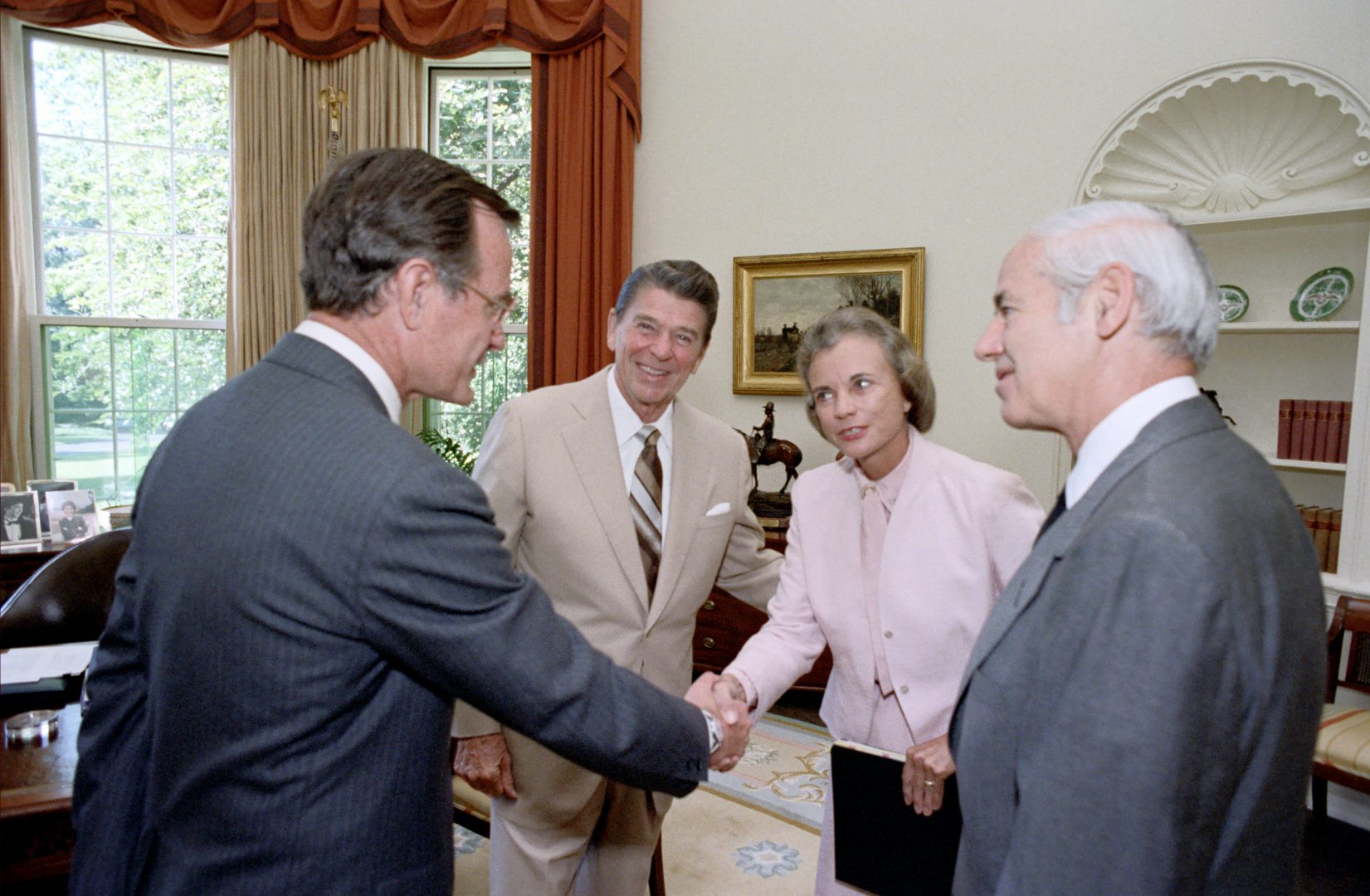
7-15-1981 President Reagan George Bush and William French Smith Meeting with Supreme Court Nominee Sandra Day O'Connor in oval office
Courtesy of Ronald Reagan Presidential Library

7-15-1981 President Reagan George Bush and William French Smith Meeting with Supreme Court Nominee Sandra Day O'Connor in oval office
Courtesy of Ronald Reagan Presidential Library

Courtesy of Ronald Reagan Presidential Library
7-15-1981 President Reagan George Bush and William French Smith Meeting with Supreme Court Nominee Sandra Day O'Connor in oval office
For 191 years, the Supreme Court of the United States was populated only by men. When President Ronald Reagan nominated Sandra Day O’Connor as the first female justice in 1981, the announcement dominated the news. Time Magazine’s cover proclaimed “Justice At Last,” and she received unanimous Senate approval. During her more than two decades on the Supreme Court, O’Connor was the critical swing vote on cases involving some of the 20th century’s most controversial issues, including race, gender and reproductive rights—and she cast the decisive vote in Bush v. Gore. Based on First: Sandra Day O’Connor by Evan Thomas, this biographical portrait recounts the life of a pioneering woman who both reflected and shaped an era.
Born in 1930 in El Paso, Texas, O’Connor grew up on a cattle ranch in Arizona, where one was judged more by ability than gender. “She never got the message that there were limits to what she could accomplish,” biographer Linda Hirshman says. After graduating near the top of her class at Stanford Law School, she could not convince a single law firm to interview her, so she turned to volunteer work and public service. Determined to have both a career and a family, she was fortunate to find a supportive partner in John O’Connor, whom she met when they were fellow students at Stanford Law. They married in 1952.
It was through John that Sandra first became involved with Arizona’s Republican Party and embarked on the path that ultimately would lead her to the Supreme Court. Tough, exacting, intensely competitive, O’Connor was also hard-working, gracious, funny, and warm––a combination that inspired both admiration and respect, and facilitated her steady ascension from precinct captain to Arizona’s Assistant Attorney General to Majority Leader of the Arizona Senate. By the time President Reagan had the opportunity to make good on his campaign promise to name a woman to the Supreme Court, O’Connor was a state judge––and so well-regarded and well-connected in Republican circles that it hardly mattered that she’d never heard a federal case.
Ironically, the only objection to her nomination came from fellow Republicans, an increasingly powerful and vocal faction of Christian conservatives who wanted to restore “family values” to America. Opposed to the ERA and bent on overturning a host of liberal Supreme Court decisions––especially Roe v. Wade, the controversial 1973 decision that established a federal right to abortion—the party’s far-right flank had forced social issues to the top of the Republican agenda, including a vow to appoint anti-abortion judges at all levels. To appease the educated female voters the party had lost in the bargain, Reagan had offered to put a woman on the Supreme Court and thought O’Connor would be a safe bet.
The fact that she was meant to be a symbol was not lost on O’Connor. She inhabited the role at times with relish and always with aplomb. Her schedule of public appearances was so frantic, some suspected she had a twin. But she wanted to be remembered for her work on the bench––work she approached with care, caution, and the firm conviction that the role of the Court was to provide a limited check on the powers of government. Social change, she believed, was a matter for legislatures; and she soon found herself increasingly at odds with the political party to which she had long since pledged her allegiance.
Over the course of her long tenure, as a succession of Republican administrations fulfilled the party’s objective to make the Court more conservative, O’Connor emerged as its center of gravity: the crucial swing vote on the issues that mattered most to most Americans. Bringing to bear negotiation skills honed as a legislator, she wielded her power to routinely and strategically press her fellow justices on both sides of the aisle to smooth out the doctrinaire edges of their opinions. To some, she seemed more politician than jurist: a judge without the courage of her convictions. To others, she was a welcome agent of comity and consensus. What no one disputed was that at a time of increasing polarization, the voice of the Court was often O’Connor’s––and more often than not, she spoke for the moderate majority.
Watch Sandra Day O’Connor: The First on American Experience Monday September 13 at 9pm on WITF. Stream the documentary on demand through the PBS Video app.
The days of journalism’s one-way street of simply producing stories for the public have long been over. Now, it’s time to find better ways to interact with you and ensure we meet your high standards of what a credible media organization should be.